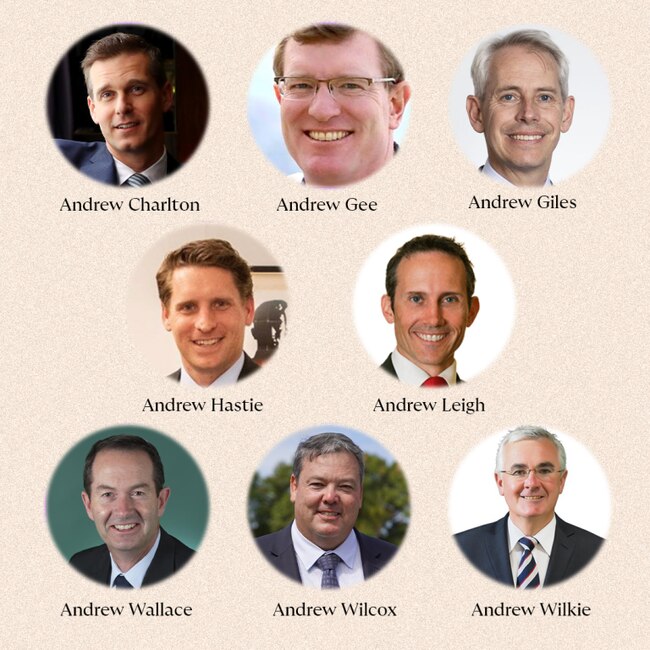More men named Andrew than female Liberals in the senate
There is a record number of women headed for Canberra, and this is only the second time women have made up more than one-third of federal politicians.

There is a record number of women headed for Canberra, and this is only the second time women have made up more than one-third of federal politicians.
There will be more men named “Andrew” than Liberal women in the lower house, when the dust settles on Scott Morrison’s crushing election defeat.
The 47th Australian parliament is set to make history with a record number of at least 95 women heading to Canberra, despite the Coalition’s female representation going backwards.
With a dozen odd spots in doubt, analysis by The Australian reveals women will make up more than 41 per cent of the 227 seats across both houses. This is only the second time women have made up more than one-third of federal politicians.
The Senate is projected to have a female majority of 58 per cent. The House of Representatives is on track for 37 per cent of female MPs, up 28 per cent from the previous parliament.
Labor will have more women in its caucus room than men for the first time, with a gender split around 53/47. The party will also have the highest number of female parliamentarians, with over 50 elected so far. Those numbers could be boosted if Sonja Baram is successful in Sturt; Naomi Oakley in Menzies, and Fiona Phillips in Gilmore.
One thing is certain — there will be more than double the number of women sitting on Anthony Albanese’s government benches than the Liberal National opposition.
The Coalition will have a minimum of 24 female members – 11 MPs and 13 senators — one less than the 46th Parliament. That number could fluctuate depending on the result in Bass, where Bridget Archer is hoping to hold on, and Lyons, where Susie Bower is in a showdown with Labor incumbent Brian Mitchell.
Based on current projects, the number of Coalition women on the House of Representatives benches will go down from 15 to 11, with just seven Liberal female MPs.
If that’s the case, the number of men named Andrew (8) will outnumber Liberal women in the lower house — Andrew Charlton, Andrew Gee, Andrew Giles, Andrew Hastie, Andrew Leigh, Andrew Wallace, Andrew Wilcox and Andrew Wilkie. And that’s before you add in Liberal senators Andrew Bragg and Andrew McLachlan.

The Andrew count could hit 11, if Andrew Constance is successful in Gilmore.
The biggest boost to female representation comes from the crossbench. There will be at least 20 women sitting on the lower and upper house crossbenches, made up of minor parties and independents, including up to eight female Greens.
At least 58 women have won a place in the House of Representatives’ 151 seats, an increase of 13 seats from the previous parliament.
Labor has increased its female representation in the lower house from 29 to at least 36 seats, while the Coalition’s numbers have dropped from 15 to 11 seats. The success of the so-called teal independents has seen the number of female crossbenchers more than triple, from 3 to 11 seats.
Women have picked up 14 lower house seats from men - Flinders, Fowler, Goldstein, Hasluck, Holt, Hughes, Kooyong, Lingiari, Mackellar, North Sydney, Pearce, Ryan, Swan and Wentworth - with female independents doing a lot of the heavy lifting.
Climate 200 backed independent Monique Ryan won Kooyong from Liberal Josh Frydenberg; Allegra Spender beat Liberal Dave Sharma in Wentworth; Sophie Scamps edged out Liberal Jason Falinski in Mackellar, Kylea Tink took North Sydney from Liberal Trent Zimmerman; Zoe Daniel edged out Liberal Tim Wilson in Goldstein.
Kristina Keneally was unsuccessful in her attempt to replace retiring Labor MP Chris Hayes in Fowler. The Western Sydney seat was won by independent Dai Le. The loss of Keneally, and Terri Butler in the seat of Griffith, will create two empty seats on Albanese’s frontbench, leaving 12 men and nine women in Labor’s ministerial team.
Labor MPs predict NSW Right senator Deborah O’Neill could be in line to take Ms Keneally’s cabinet spot, while NSW Left senator Jenny McAllister is likely to replace Ms Butler. South Australian Right powerbroker Don Farrell will take over as the government’s deputy leader in the Senate, a position vacated by Ms Keneally.
Labor has held onto two seats with retiring male members: Cassandra Fernando will replace Anthony Byrne in Holt; and Marion Scrymgour is on track to keep Lingiari red after the exit of Warren Snowdon.
Over in Western Australia, Labor women have flipped three seats from Liberal men. Tania Lawrence defeated Ken Wyatt in Hasluck, Tracey Roberts took retiring Christian Porter’s seat of Pearce; and Zaneta Mascarenhas won outgoing Steve Irons’ seat of Swan.
In Flinders, Liberal Zoe McKenzie has replaced retiring Liberal Greg Hunt; Liberal Jenny Ware has replaced turncoat Craig Kelly in Hughes; and the Greens Elizabeth Watson-Brown secured the Brisbane seat of Ryan from Liberal Julian Simmonds.
The number of male held seats in the lower house is set to decrease, down from 104 in the 46th parliament.
In the count thus far, men have picked up three seats from women: the Greens’ Max Chandler-Mather has taken Griffith from Labor’s Terri Butler; Labor’s Gordon Reid has won Robertson from Liberal Lucy Wicks; and in Parramatta, Labor’s Andrew Charlton has replaced retiring Labor member Julie Owens.
Women will make up more than half of the Senate, with female politicians on track to pick up 39 of the 76 seats, up four since 2019.
Labor women are doing a lot of heavy lifting in the upper house, where they will outrank their male colleagues 18 to 9. All four of Labor’s Tasmanian Senate seats are held by women — Anne Urquhart, Helen Polley, Catryna Bilyk and Carol Brown.
The Coalition is on track to hold 30 upper house seats, 18 by men and 12 by women.
The Greens look likely to pick up two new female senators, Barbara Pocock in South Australia and Penny Allman-Payne in Queensland. That would give the minor party 12 senate seats, up three from 2019.
One Nation leader Pauline Hanson is fighting to retain a Senate seat in Queensland and the Jacqui Lambie Network is in the mix to pick up a second Senate seat in Tasmania for Tammy Tyrrell.
The sixth South Australian seat looks likely go to One Nation’s Jennifer Game and Labor’s Fatima Payman is set to pick up the final seat in Western Australia.
Both Senate seats in the Northern Territory will be held by indigenous women — Labor’s Malarndirri McCarthy and Country Liberal Jacinta Nampijinpa Price.
Five of the six senators elected in NSW at the weekend’s poll were women — Labor’s Linda White and Jana Stewart, Liberal Sarah Henderson, National Bridget McKenzie and Greens Lidia Thorpe.


